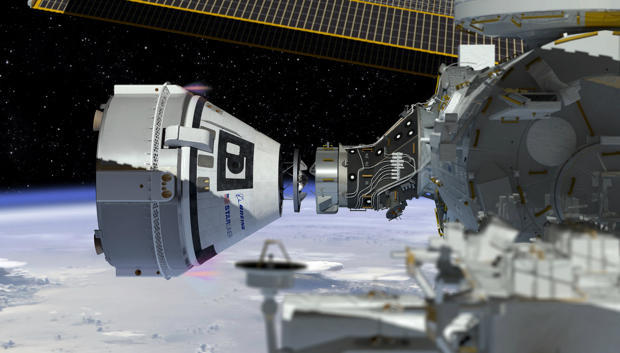5.11.2019
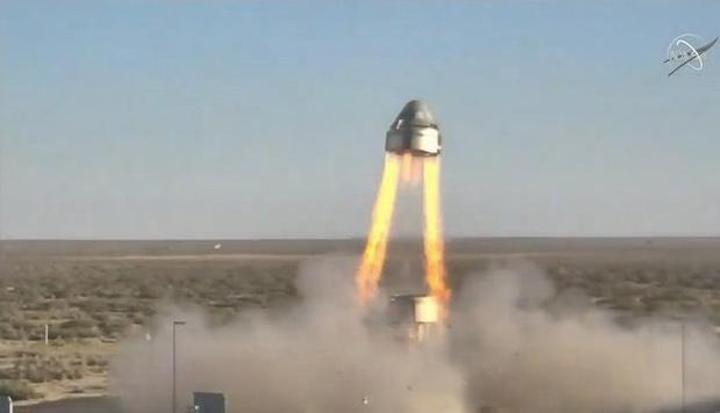
A Boeing CST-100 Starliner capsule streaks away from the White Sands Missile Range in New Mexico during a test of the spacecraft's emergency abort system.
In a spectacular test, Boeing fired an unpiloted Starlinercrew capsule's abort engines Monday, triggering a high-speed boost from ground level to a height of more than 4,000 feet to prove the spacecraft can safely propel a crew to safety in the event of a catastrophic booster failure.
While one of three main parachutes failed to deploy during the capsule's descent, Boeing officials said the spacecraft was designed to land safely with just two and that the abort system met the requirements for a successful test.
"We will review the data to determine how all of the systems performed, including the parachute deployment sequence," a spokesman said. "It's too early to determine why all three main parachutes did not deploy, however, having two of three deploy successfully is acceptable for the test parameters and crew safety."
Chris Ferguson, commander of NASA's final shuttle mission and now a senior manager with Boeing, will join two NASA astronauts for the first piloted flight of a Starliner next year. He said the abort system "worked pretty much the way I always envisioned. ... Hopefully our NASA customers are equally happy with the progress we've made."
Mounted atop a short support platform at the White Sands Missile Range in New Mexico, the Starliner's four powerful launch abort engines, along with 20 smaller maneuvering jets, ignited at 9:15 a.m. EST, accelerating the capsule, carrying an instrumented test dummy, from zero to 650 mph — straight up — in just five seconds.
Belching jets of fiery exhaust, the big abort engines shut down as planned at the end of that five seconds, followed by the maneuvering thrusters about five seconds after that.
The capsule continued climbing, arcing over at the high point of its trajectory and flipping about to put its base in the direction of travel. After jettisoning its forward heat shield, drogue parachutes deployed and stabilized the spacecraft before two red-and-white main parachutes unfurled about 26 seconds into the flight.
It was not obvious in tracking camera video what prevented the third parachute from unfurling.
"On the good side, the vehicle is designed to safely land with two parachutes," Ferguson told Spaceflight Now in a post-test interview. "It's designed to safely land with five of six airbags. There's redundancy in there. While it was unintentional, we demonstrated that you can safely land with two parachutes. So I look at that as a plus."
He said Boeing engineers will study the anomaly to find out what went wrong, adding "we'll make sure that we understand what the root cause was and make sure that we've adequately mitigated whatever caused it before we take humans on board."
Unlike the Apollo lunar capsules that ended their flights with ocean splashdowns, the Starliner is designed to land at ground facilities in the western U.S., jettisoning its heat shield and inflating airbags to cushion impact while descending under the main parachutes.
For Monday's test, the two main parachutes and airbags appeared to work normally and the Starliner descended to a relatively gentle touchdown about a minute and a half after takeoff.
In an actual launch abort, the Starliner would land in the Atlantic Ocean northeast of Cape Canaveral.
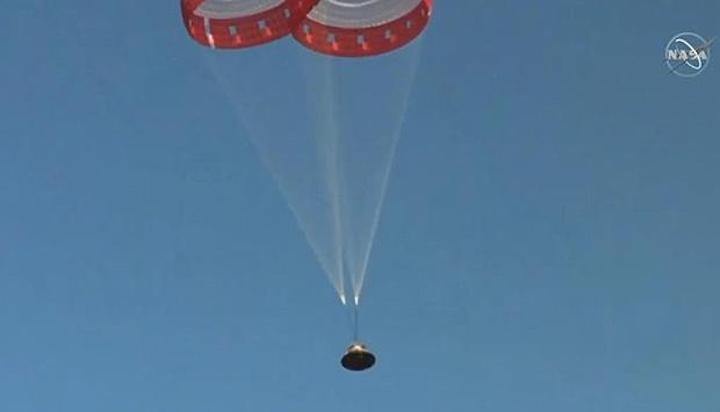
The CST-100 capsule descends to touchdown under two huge parachutes after a high-speed launch to test the rocket motors and other systems a crew would rely on to escape a catastrophic booster failure. One parachute failed to deploy.
Boeing has encountered a variety of technical hurdles and setbacks during Starliner development, putting the program well behind schedule. But the long-awaited pad abort test marks a key milestone in the company's drive to finally ready the CST-100 Starliner for an unpiloted flight to the International Space Station (ISS). Despite the parachute anomaly, a Boeing spokesman said the company is still targeting Dec. 17 for the test flight.
If that test goes well, Boeing and NASA will set their sights on a piloted test early next year that will carry three crew members to the space station for a six-month stay.
SpaceX also is building an astronaut ferry ship, known as the Crew Dragon, that also is in the final stages of preparation for piloted flights to the space station. Unlike the Starliner, the Crew Dragon is designed to end its missions with ocean splashdowns.
The Crew Dragon already has completed a low-altitude pad abort test and an uncrewed flight to the station. An in-flight abort test is planned for early December, setting the stage for a piloted flight to ISS sometime next year.
Both companies face multiple technical hurdles and reviews before operational crew rotation flights can begin, and it's not yet known which spacecraft will launch a crew into orbit first.
However it plays out, NASA managers are hopeful 2020 will mark the end of a nine-year hiatus in U.S. human spaceflight that began with the space shuttle's retirement in 2011.
Boeing holds NASA contracts valued at $4.2 billion to build and launch the Starliner while SpaceX was awarded $2.6 billion for Crew Dragon development. The goal is to end the agency's sole reliance on Russian Soyuz spacecraft to ferry astronauts to and from the space station.
Both commercial crew ships are designed to enable safe aborts at any point from the launch pad to orbit.
While SpaceX already has carried out an on-pad abort test and plans an in-flight demonstration, Boeing engineers said the White Sands test should suffice to demonstrate the Starliner abort system will work as required if a crew ever needs to escape from its Atlas 5 booster.
The capsule is equipped with four powerful launch abort engines, or LAEs, each one generating 40,000 pounds of thrust, and 20 orbital maneuvering and attitude control — OMAC — engines providing 1,500 pounds of push each.
The launch abort engines would only be used in an actual low- to mid-altitude abort while the OMAC engines would normally be used to complete the spacecraft's trip to orbit after separation from its Atlas 5 second stage. During a low-altitude abort, the OMAC engines are used to provide additional thrust and attitude control.
The Starliner also is equipped with 28 less-powerful reaction control system engines for use during high-altitude aborts and, in a problem-free flight, to make small changes in the spacecraft's orbit and for docking with the ISS.
Quelle: CBSNews
+++
Boeing tests crew capsule escape system
WHITE SANDS MISSILE RANGE, New Mexico — A Boeing Starliner crew capsule fired off a stand early Monday at White Sands Missile Range in New Mexico on a mile-high test flight to validate the spacecraft’s emergency escape thrusters.
Only two of the ship’s three main parachutes deployed on descent, but Boeing officials do not expect any impacts on the planned launch of an unpiloted Starliner demonstration mission to the International Space Station in December.
The capsule did not fly with any astronauts Monday when it launched off a pad at White Sands on a fast-paced test flight, which lasted around 78 seconds from liftoff through landing.
But a lot happened during the flight, called a pad abort test, exercising the Starliner spacecraft’s abort engines, control thrusters, flight software, jettison mechanisms and parachutes.
The 16.5-foot-tall (5-meter) capsule propelled itself off its test stand at 7:15 a.m. MST (9:15 a.m. EST; 1415 GMT) Monday. The Starliner used the same launch pad originally built for a pad abort test of NASA’s Orion crew capsule in 2010.
Other than the parachute deployment failure, everything appeared to work as designed on Monday’s pad abort test.
“It’s designed to operate with two chutes, and operate well,” said Chris Ferguson, a Boeing test pilot and astronaut who will fly on the Starliner’s first crewed space mission next year. “Everything landed well, all the airbags functioned properly. I was just super-jazzed that we got to where we were.”
In a statement after Monday’s test, Boeing said engineers will review data from Monday’s pad abort test to “determine how all of the systems performed, including the parachute deployment sequence.”
“It’s too early to determine why all three main parachutes did not deploy, however, having two of three deploy successfully is acceptable for the test parameters and crew safety,” Boeing said in a statement. “At this time we don’t expect any impact to our scheduled Dec. 17 Orbital Flight Test. Going forward, we will do everything needed to ensure safe orbital flights with crew.”
During a crewed launch, emergency escape engines on the base of the Starliner’s service module would propel the spacecraft off the top of its United Launch Alliance Atlas 5 rocket in the event of a failure on the launch pad at Cape Canaveral. The pad abort test Monday proved the Starliner’s escape system is up to the challenge.
“This is a system we hope to never use, but it’s a system that we have to have so that we can have the ability to abort any time on the way up, whether we’re on the pad all the way to aborting to orbit,” said Mike Fincke, a veteran NASA astronaut who will join Ferguson on the Starliner’s Crew Flight Test. “And today we saw a successful test, where we saw that the our revolutionary pusher abort system could pull us away from a launch vehicle that was in trouble and get us a mile up and a mile across away to safety.”
First-time space flier Nicole Mann, a U.S. Marine Corps test pilot, will join Ferguson and Fincke on the Crew Flight Test to the space station. The astronauts are expected to live and work aboard the orbiting research complex for up to six months.
Boeing is developing the Starliner spacecraft under a $4.2 billion contract with NASA. The space agency also awarded a $2.6 billion contract to SpaceX for development of the Crew Dragon spacecraft, giving NASA two new commercial crew capsules to fly astronauts to the space station, ending U.S. reliance on Russian Soyuz vehicles for the job.

Monday’s pad abort test at White Sands went by quickly, with a few flashes and bangs before two of the three main parachutes opened and six airbags inflated to bring the capsule gently back to the ground.
“While it was unintentional, we demonstrated that you can safely land with two parachutes, so I look at that as a plus,” Ferguson said. “We’re certainly going to look at what happened to the third (parachute).
“Parachutes are obviously a very important element in all of this, and there’s a fair amount of concern that’s arisen lately over parachutes, not just in our program but across all human spaceflight programs,” Ferguson said in an interview with Spaceflight Now after Monday’s pad abort test. “Even on Mars, you’ve seen they’ve had some problems with ExoMars and their parachutes. So we’ll take a very good look at this. We’ll make sure that we understand what the root cause was, and make sure that we’ve adequately mitigated whatever caused it before we take humans on-board.”
An early assessment of video imagery and data from Monday’s test flight suggests the third main parachute never deployed, Boeing officials said. Engineers will inspect the recovered crew module to search for the cause of the parachute issue.
“Some of the folks who have the opportunity to go back and review it say that the pilot chute did come out, but then we don’t know what happened after that,” Ferguson told Spaceflight Now. “The pilot chute is designed to pull the main chute out, and we confirmed that the pilot chute came out, which means that the mortar that fires the pilot chute functioned properly, but what happened beyond that, it’s too early to speculate.”
Ferguson reiterated the official Boeing statement suggesting the company expects the parachute issue to have no impact on the Dec. 17 launch date for the Starliner’s first test flight in space.
He said there are “subtle differences” in the parachute system between the pad abort test vehicle, which is not intended to fly in space, and the next two Starliner spaceships. The differences “would enable us to confidently go into OFT without having to sort of retract and go and fix a problem that we observed,” Ferguson said.
“But again, we have to wait for the … investigation to sort of play out and make sure we understood what the root cause of it was,” he said.

Although the pad abort test capsule lacked some crew systems, such as cockpit displays, the spacecraft tested Monday is largely the same as the two reusable space-rated capsules under construction at NASA’s Kennedy Space Center in Florida.
“This is a full-up Starliner,” said Alicia Evans, Boeing’s pad abort test flight director, in a NASA podcast last week. “It’s been built up specifically for this test. But because we were testing the integrated system, it has all of the systems required for the pad-abort test, and it’s full-up avionics capability, propulsion.”
At the start of Monday’s test flight, a command triggered specially-designed valves to quickly open inside the Starliner’s service module, and a high-pressure mix of liquid hydrazine and nitrogen tetroxide propellants rushed into four launch abort engines, or LAEs. The chemical propellants automatically combusted when mixed together, generating 40,000 pounds of thrust from each of the Aerojet Rocketdyne-made engines.
The engines, coupled with thrust from 12 smaller orbital maneuvering and attitude control rockets, or OMACs, pushed the Starliner vehicle off the ground with nearly 180,000 pounds of thrust. The capsule was expected to experience a sustained force of 5 Gs for five seconds while the launch abort engines fired, the same force astronauts would be under during a real abort off the launch pad.
Before Monday’s test, the Starliner capsule was mounted on top of the same type of adapter that will connect the real spacecraft to the top of ULA’s Atlas 5 rocket. When the craft ignited its four launch abort engines, vent doors on the adapter were designed to open, preventing an over-pressure event.
“At the launch pad, you have the rocket standing next to its gantry,” Evans said. “You have a launch vehicle adapter, which is structural hardware that adapts the launch vehicle to the Starliner. So that’s how we interface to it. Then you have the Starliner sitting on top of the rocket. And we have a service module as well as a crew module, which is the (combined) Starliner.
“During an abort, if there was to be an accident with the rocket and we needed to save the crew, what would happen is we have four large launch abort engines that fire in conjunction with several more smaller thrusters, called our orbital maneuvering and attitude control thrusters,” Evans said. “And that combined collection of thrusters lifts the Starliner away from the rocket and outside of any debris or blast zone that might be created by a rocket.”

During Monday’s test, the abort engines were to fire for 5.1 seconds, propelling the Starliner from zero to some 650 mph.
Then thrusters pulsed to flip the spacecraft around and fly tail first on an arc that was expected to take the vehicle to a maximum altitude of approximately 4,426 feet (1,349 meters) above ground level around 18.6 seconds after takeoff.
The thrusters stopped firing 17 seconds after takeoff, and a series of pilot, drogue and main parachutes began deploying at about T+plus 20 seconds.
The craft jettisoned its service module at T+plus 34 seconds to fall to the ground. The crew module then released its base heat shield, then inflated airbags to cushion the capsule’s landing at White Sands.
On an actual space mission, the Starliner’s service module will separate from the crew module in space, then burn up during re-entry into the atmosphere. Engineers were eager to capture video tracking of the jettison system’s function during the pad abort test, along with observations of the heat shield separation events.
Residual propellant inside the service module, which contains all the engines used for the abort test, ignited with a flash upon impact. The crew module descended to its airbag-cushioned landing nearby.
SpaceX completed the pad abort test for its Crew Dragon spacecraft at Cape Canaveral in 2015, and plans an in-flight abort test later this year at the Kennedy Space Center to verity the capsule’s ability to fire off a Falcon 9 rocket after liftoff. Boeing plans to bypass such an in-flight abort demonstration.
Other U.S. space capsules, such as the Apollo command module, the Orion crew vehicle, and SpaceX’s Crew Dragon, are designed to splash down in the sea under parachutes. The Starliner, like Russia’s Soyuz spacecraft, will come back to Earth and touch down on land.
Under the guidelines of the commercial crew contracts, NASA gave Boeing and SpaceX the option to decide whether or not to conduct an in-flight abort test.
“Boeing is not going to do an in-flight abort test,” said Jon Cowart, deputy manager of the mission management office for NASA’s commercial crew program, before the pad abort test. “They’re just going to do the ground one. They think that they can get enough data and then extrapolate that out, with good analytical techniques that we’ve endorsed. They will go and do it in that particular way, versus SpaceX, which is going to do both.
“We knew about this up front, both Boeing and SpaceX, when they proposed their contracts to us and said, ‘This is how we’re going to get to real flights,'” Cowart said last week in a NASA podcast. “We understood exactly, and we bought into it. We think, and we agree with them, that we can get all they need from a pad-abort test.”
Kathy Lueders, who manages the commercial crew program at NASA, last week called the Boeing pad abort “a huge test for us.”
“Obviously, it’s going to be important for us to understand how the separation works for the CM and SM (crew module and service module), checking out the chutes, making sure that the predictions are lined up right for us,” Lueders said last week during a presentation to the NASA Advisory Council’s human exploration and operations committee.
Boeing is in the final stages of assembling and testing two space-ready Starliner vehicles inside a former space shuttle hangar at NASA’s Kennedy Space Center in Florida.
The first of the capsules is scheduled to launch on an Atlas 5 rocket as soon as Dec. 17 from pad 41 at Cape Canaveral Air Force Station for a week-long unpiloted test flight to the space station. That mission, called the Orbital Test Flight, will not have an active abort system, but Lueders said NASA wants to see how the Starliner performs on the abort test before going ahead with the OFT mission.
“OFT does not have the abort system on it because it’s an uncrewed mission, but obviously the way the system separates and everything else will reflect on our OFT progress, so it’s critical for us to get this test going and that we understand it prior to us doing rollout of the spacecraft (for OFT),” Lueders said last week, referencing the pad abort test.
The Starliner’s Crew Flight Test to the space station is scheduled to follow some time in the first half of 2020, with Ferguson, Fincke and Mann on-board.
While final preparations for the pad abort test were underway in New Mexico, Boeing technicians at the Kennedy Space Center in Florida were readying the first space-ready Starliner spacecraft for fueling. Later this month, it will be installed on top of the Atlas 5 rocket at Cape Canaveral for final integrated checkouts and a full countdown rehearsal ahead of its scheduled liftoff in mid-December.
The commercial crew program is a new paradigm for NASA. Boeing and SpaceX are in charge, but because NASA is the only customer for the new spaceships so far, the government still has a big say in how the contractors run the program.
“They own the flight tests,” Cowart said. “Even when they start flying up in the space station, they own the spaceship, they own the rocket. But these particular tests — they own them, which means we will consult with them, but in the end, they are the ones who own the tests and the results.
“It’s part of their certification,” he said. “They’ve got to bring the data from those tests to us before they can go fly our astronauts on-board. And we’ve got to say that, ‘Yeah, you’ve got the right amount of data and that the data is good and that the vehicle will perform correctly.’ But … this is the thing that’s kind of different from the way NASA has done business in the past. We don’t own the rocket. We don’t own the spaceship … It’s something more than consulting and something less than owning.”
Quelle: SN
+++
SpaceX says Crew Dragon parachute upgrade nailed more than a dozen tests in a row
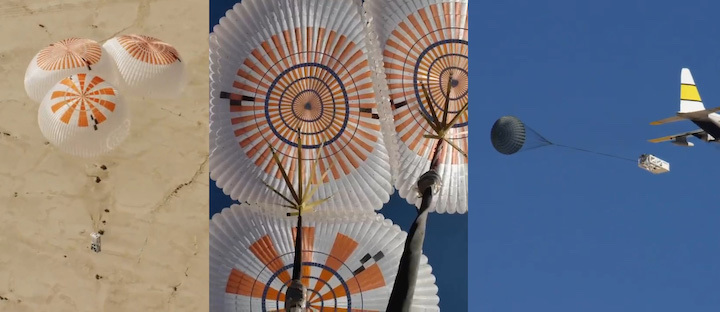
According to SpaceX, Crew Dragon’s upgraded ‘Mk3’ parachutes have successfully completed more than a dozen tests in a row, a feat accomplished by SpaceX engineers and technicians in a single week.
Although SpaceX will likely continue to test the upgraded parachutes over the next several weeks and months, Mk3’s success up to now – including a demonstration of an emergency landing scenario – likely means that the company is well on track for NASA to certify Crew Dragon for its first astronaut launch.
Known as Demo-2, SpaceX’s first crewed demonstration mission is tentatively scheduled to launch no earlier than the first quarter of 2020 and is almost entirely dependent upon NASA (and SpaceX, to a lesser extent) completing review and qualification paperwork. On October 8th, SpaceX CEO Elon Musk indicated that SpaceX itself – including all Crew Dragon and Falcon 9 hardware – would likely be ready to launch before the end of December 2019.
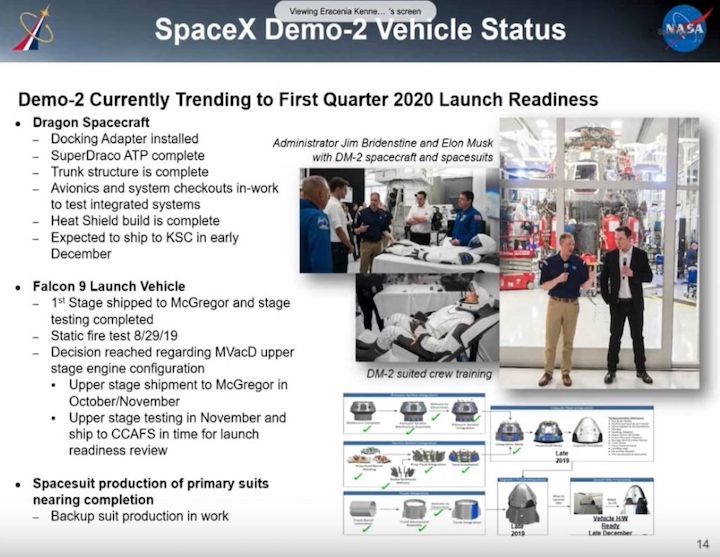
During an October 30th briefing from Commercial Crew Program manager Kathy Lueders, NASA essentially confirmed Musk’s estimate for Crew Dragon hardware readiness, estimating that the Crew Dragon Demo-2 spacecraft will be ready for flight around the end of December. The mission’s Falcon 9 booster has also completed testing in Texas, while SpaceX plans to ship the Falcon 9 upper stage to Texas for acceptance testing in November.
In recent months, NASA has indicated that the parachute systems of both Boeing’s Starliner and SpaceX’s Crew Dragon were a prominent concern after chute failures occurred on several occasions. In response, SpaceX redesigned Crew Dragon’s parachutes – supplied by Airborne Systems – to account for the failure modes experience, while also advancing the state of the art of computer modeling of parachute deployment and behavior.
In response to past failures, SpaceX chose to further upgrade and strengthen Crew Dragon’s parachutes, moving to a ‘Mk3’ variant with stronger Zylon risers (strips connecting Dragon to its parachute rigging), among other tweaks. Notably, in an October 2019 press conference with Musk, NASA administrator Jim Bridenstine noted that SpaceX had plans to field and test those Mk3 parachutes at least 10 times before the end of 2019.
“We could see as many as 10 drop tests between now and the end of the year and depending on how the next 10 drop tests go, we will know how many more drops tests we are going to add.”
Jim Bridenstine, October 10th, 2019
In fact, during the latest stage of testing, SpaceX says it successfully completed thirteen consecutive tests of Crew Dragon’s new Mk3 parachutes, all of which were completed in less than two weeks. This essentially blows Bridenstine’s expectations out of the water, as SpaceX has surpassed his predicted 10 tests and done so barely three weeks into the tentative 12-week window he set. SpaceX now has plenty of time to either continue testing Crew Dragon’s parachutes or refocus its efforts on other equally important qualification challenges.
Prior to those thirteen consecutive successes, SpaceX suffered two failures during single-parachute Mk3 testing. The first two development tests of the Mk 3 design used loads much higher than the parachutes would ever see in operation in an effort to better understand overall design margins and system performance. After a period of rapid iteration with parachute provider Airborne Systems, the faults responsible for those two stress-test failures were resolved and subsequent drop tests confirmed that Mk3’s suspension lines – the numerous lines connecting the parachute to Crew Dragon – are far stronger than those on Mk2.
Perhaps most crucially, the most recent test – shown in the video shared by SpaceX on November 3rd – was the first multi-chute Mk3 demonstration and simultaneously proved that Crew Dragon will be able to safely land its astronaut passengers even if one of the spacecraft’s four parachutes fail to deploy. Despite those consecutive successes, SpaceX and Airborne will continue testing Mk3 parachutes as rapidly as possible and aim to provide NASA the data it needs to qualify Crew Dragon’s parachutes for crewed flight before the end of 2019.
Either way, the next several months are set to be a frenetic period for NASA’s Commercial Crew Program. As early as November 4th, Boeing aims to attempt a pad abort test of its Starliner spacecraft, while SpaceX is set to static fire a Crew Dragon capsule on November 6th. If both tests are successful, SpaceX aims to launch Crew Dragon’s In-Flight Abort (IFA) test in early-December, while Boeing hopes to launch Starliner on its first uncrewed Orbital Flight Test (OFT) no earlier than December 17th.
Quelle: TESLARATI

